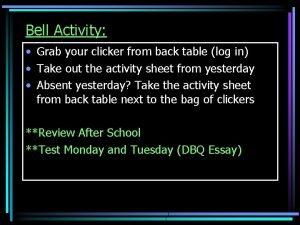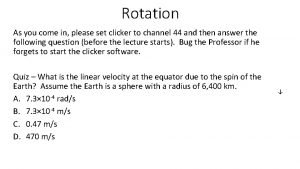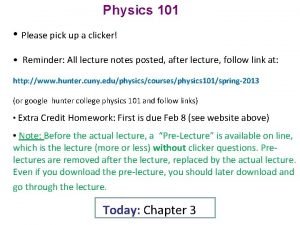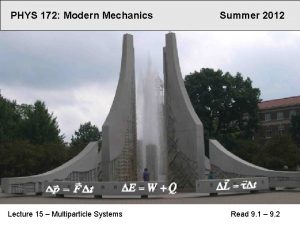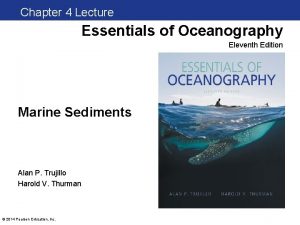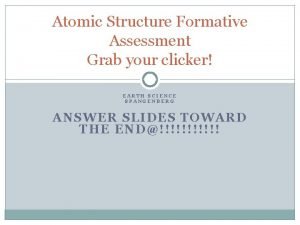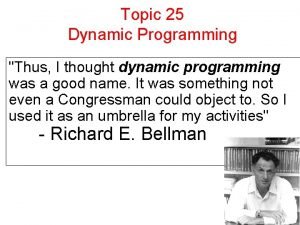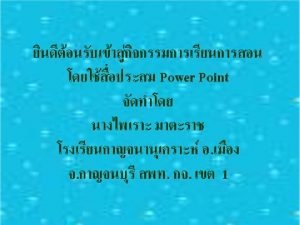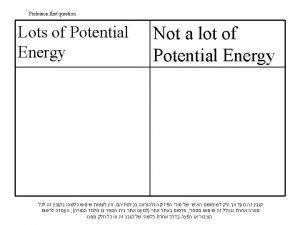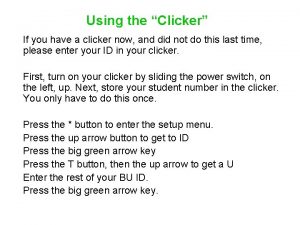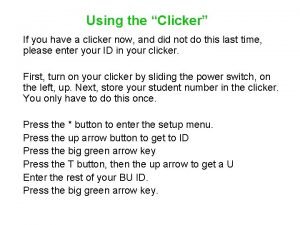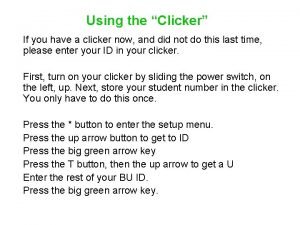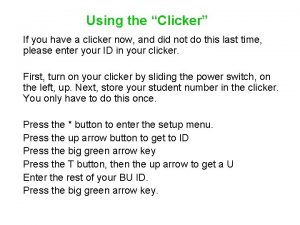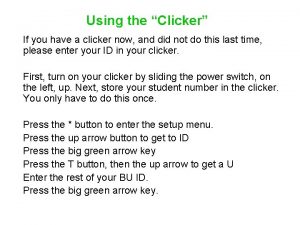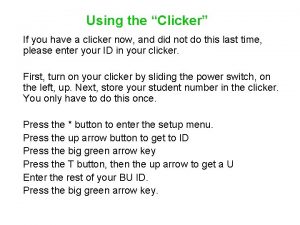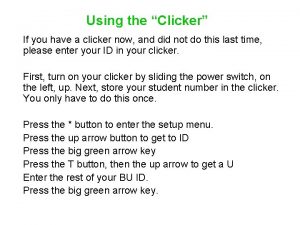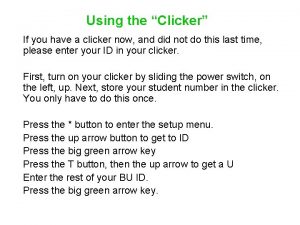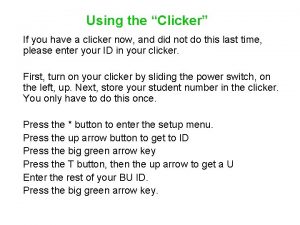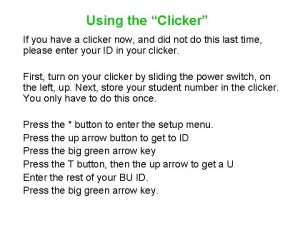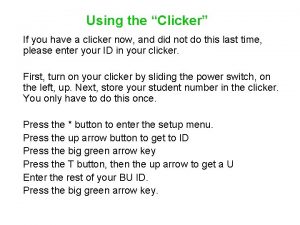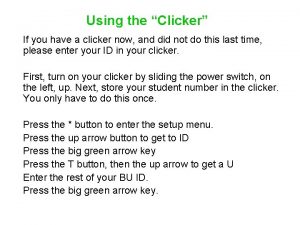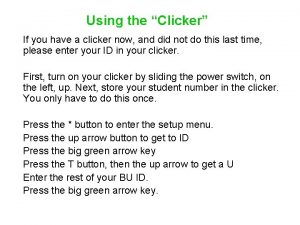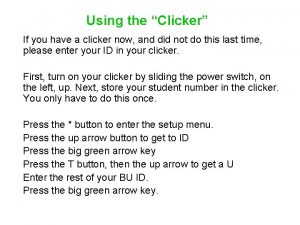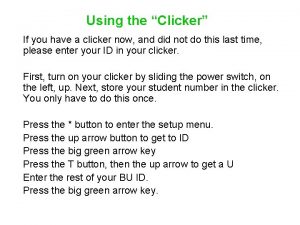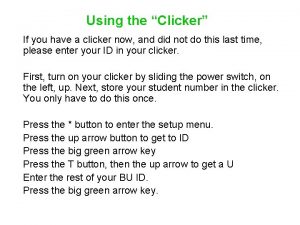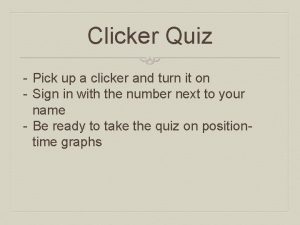Using the Clicker If you have a clicker



































- Slides: 35

Using the “Clicker” If you have a clicker now, and did not do this last time, please enter your ID in your clicker. First, turn on your clicker by sliding the power switch, on the left, up. Next, store your student number in the clicker. You only have to do this once. Press the * button to enter the setup menu. Press the up arrow button to get to ID Press the big green arrow key Press the T button, then the up arrow to get a U Enter the rest of your BU ID. Press the big green arrow key.

Newton’s First Law for Rotation An object at rest tends to remain at rest, and an object that is spinning tends to spin with a constant angular velocity, unless it is acted on by a nonzero net torque or there is a change in the way the object's mass is distributed. The net torque is the vector sum of all the torques acting on an object. The tendency of an object to maintain its state of motion is known as inertia. For straight-line motion mass is the measure of inertia, but mass by itself is not enough to define rotational inertia.

Rotational Inertia How hard it is to get something to spin, or to change an object's rate of spin, depends on the mass, and on how the mass is distributed relative to the axis of rotation. Rotational inertia, or moment of inertia, accounts for all these factors. The moment of inertia, I, is the rotational equivalent of mass. For an object like a ball on a string, where all the mass is the same distance away from the axis of rotation: If the mass is distributed at different distances from the rotation axis, the moment of inertia can be hard to calculate. It's much easier to look up expressions for I from the table on page 291 in the book (page 10 -15 in Essential Physics).

A table of rotational inertias

The parallel axis theorem If you know the rotational inertia of an object of mass m when it rotates about an axis that passes through its center of mass, the object’s rotational inertia when it rotates about a parallel axis a distance h away is:

Worksheet, part 2 When a system is made up of several objects, its total rotational inertia about a particular axis is the sum of the rotational inertias of the individual objects for rotation about that axis. What is the system’s rotational inertia in the first case? Each block has a mass of m/3, and the rod, of negligible mass, has a length L.

Worksheet, part 2 When a system is made up of several objects, its total rotational inertia about a particular axis is the sum of the rotational inertias of the individual objects for rotation about that axis. What is the system’s rotational inertia in the first case?

Worksheet, part 2 In the second case, do we expect the rotational inertia to be larger, smaller, or the same as the rotational inertia in the first case? What is the system’s rotational inertia in the second case?

Worksheet, part 2 In the second case, do we expect the rotational inertia to be larger, smaller, or the same as the rotational inertia in the first case? Larger – the mass is farther from the axis. What is the system’s rotational inertia in the second case?

Worksheet, part 2 In the second case, do we expect the rotational inertia to be larger, smaller, or the same as the rotational inertia in the first case? Larger – the mass is farther from the axis. What is the system’s rotational inertia in the second case? The parallel-axis theorem gives the same result.

Newton’s Second Law for Rotation The equation is the rotational equivalent of Torque plays the role of force. Rotational inertia plays the role of mass. Angular acceleration plays the role of the acceleration. .

Applying Newton’s Second Law A constant force of F = 8 N is applied to a string wrapped around the outside of the pulley. The pulley is a solid disk of mass M = 2. 0 kg and radius R = 0. 50 m, and is mounted on a horizontal frictionless axle. What is the pulley's angular acceleration? Simulation What should we do first? Why are we told that the pulley is a solid disk?

Applying Newton’s Second Law A constant force of F = 8 N is applied to a string wrapped around the outside of the pulley. The pulley is a solid disk of mass M = 2. 0 kg and radius R = 0. 50 m, and is mounted on a horizontal frictionless axle. What is the pulley's angular acceleration? Simulation What should we do first? Draw a free-body diagram of the pulley. Why are we told that the pulley is a solid disk?

Applying Newton’s Second Law A constant force of F = 8 N is applied to a string wrapped around the outside of the pulley. The pulley is a solid disk of mass M = 2. 0 kg and radius R = 0. 50 m, and is mounted on a horizontal frictionless axle. What is the pulley's angular acceleration? Simulation What should we do first? Draw a free-body diagram of the pulley. Why are we told that the pulley is a solid disk? So we know what to use for the rotational inertia.

Applying Newton’s Second Law

Two pulleys Simulation We take two identical pulleys, both with string wrapped around them. On the on the left we apply an 8 N force to the string. On the on the right we hang an object with a weight of 8 N. Which pulley has the larger angular acceleration?

Two pulleys We take two identical pulleys, both with string wrapped around them. On the on the left we apply an 8 N force to the string. On the on the right we hang an object with a weight of 8 N. Which pulley has the larger angular acceleration? 1. 2. 3. 4. The on the left The on the right Neither, they're equal

Two pulleys For the pulley on the left, the tension in the string is 8 N. Simulation For the system on the right, let’s draw the free-body diagram of the weight. What does the free-body diagram tell us about the tension in the string?

Two pulleys For the pulley on the left, the tension in the string is 8 N. For the system on the right, let’s draw the free-body diagram of the weight. What does the free-body diagram tell us about the tension in the string? For the weight to have a net force directed down, the tension must be less than the force of gravity. So, the tension is less than 8 N.

Atwood’s machine involves one pulley, and two objects connected by a string that passes over the pulley. In general, the two objects have different masses.

Re-analyzing the Atwood’s machine When we analyzed Atwood’s machine earlier, we found an expression for the acceleration of the weights in terms of m, M, and g, but we neglected the mass of the pulley. When we include the pulley in the analysis, we find that: 1. The acceleration is larger. 2. The acceleration is smaller. 3. The acceleration is the same.

What’s the difference? The acceleration turns out to be less than what we found before, because we need to accelerate the pulley. In the analysis, we use two different tension forces. The tension on the right is larger than the tension on the left to give a net clockwise torque to accelerate the pulley clockwise.

Analyzing the lighter object Sketch a free-body diagram for the lighter object. Choose a positive direction, and apply Newton’s Second Law.

Analyzing the lighter object Sketch a free-body diagram for the lighter object. Choose a positive direction, and apply Newton’s Second Law. Let’s choose positive to be up, in the direction of the acceleration.

Analyzing the heavier object Sketch a free-body diagram for the heavier object. Choose a positive direction, and apply Newton’s Second Law.

Analyzing the heavier object Sketch a free-body diagram for the heavier object. Choose a positive direction, and apply Newton’s Second Law. Choose positive down this time, to match the object’s acceleration.

Analyzing the pulley Sketch a free-body diagram for the pulley. Choose a positive direction, and apply Newton’s Second Law for rotation.

Analyzing the pulley The pulley is a uniform solid disk with mass mp and radius R. Sketch a free-body diagram for the pulley. Choose a positive direction, and apply Newton’s Second Law. Choose positive clockwise, to match the pulley’s angular acceleration.

Combine the equations Lighter object: Heavier object: Pulley:

Combine the equations Lighter object: Heavier object: Pulley: Add the equations: Previous result

Rolling View 1 View 2 View 3 View 4 • We can view rolling motion as a superposition of pure rotation and pure translation. • For rolling without slipping, the rotational speed of the outside of the wheel equals the translational speed. • The net instantaneous velocity at the bottom of the wheel is zero, while at the top it is twice the translational velocity of the wheel.

An accelerating car You are driving your front-wheel drive car on Comm. Ave. You are stopped at a red light, and when the light turns green you accelerate smoothly so that there is no slipping between your car tires and the road. During the acceleration period, in what direction is the force of friction from the road acting on your front tires? Is it static friction or kinetic friction? 1. The frictional force is kinetic friction acting in the direction you are traveling. 2. The frictional force is kinetic friction acting opposite to the direction you are traveling. 3. The frictional force is static friction acting in the direction you are traveling. 4. The frictional force is static friction acting opposite to the direction you are traveling.

An accelerating car During the acceleration period, in what direction is the force of friction from the road acting on your rear tires? Is it static friction or kinetic friction? 1. The frictional force is kinetic friction acting in the direction you are traveling. 2. The frictional force is kinetic friction acting opposite to the direction you are traveling. 3. The frictional force is static friction acting in the direction you are traveling. 4. The frictional force is static friction acting opposite to the direction you are traveling.

An accelerating car Car simulation Let’s first turn friction off. With no friction at all, pushing down on the accelerator makes the front wheels spin clockwise. They spin on the frictionless surface, the rear wheels do nothing, and the car goes nowhere. Friction on the front wheels opposes the spinning, so it must point in the direction the car wants to go. For the front wheels to roll without slipping, the friction must be static. If we turn on friction to the front wheels only, the car accelerates forward with the back wheels dragging along the road without spinning. Friction opposes this motion, so it must point opposite to the way the car is going. Again, it must be static friction. The static friction force acting on the front wheels is the force that accelerates the car forward. It is much larger than the friction force on the rear wheels, which just has to give the rear wheels the correct angular acceleration.

Whiteboard
 They have not rejected you
They have not rejected you 8 vertices, and 6 faces
8 vertices, and 6 faces Math clicker
Math clicker E clicker
E clicker Turning point audience response
Turning point audience response Lesson 5 building an app clicker game
Lesson 5 building an app clicker game Earth clicker
Earth clicker Heart rate clicker
Heart rate clicker Hitler clicker
Hitler clicker Clicker stop motion
Clicker stop motion Cooi clicker
Cooi clicker Umbc clicker
Umbc clicker Clicker box
Clicker box Roger rabbit
Roger rabbit Clicker stop motion
Clicker stop motion Clicker
Clicker Particl clicker
Particl clicker Pid lisom
Pid lisom Salt clicker
Salt clicker Clicker gravel transport
Clicker gravel transport Atomic clicker
Atomic clicker Spacebar click
Spacebar click Fibonacci clicker
Fibonacci clicker Question ball questions
Question ball questions Presentation clicker challenger
Presentation clicker challenger Sohcahtoa practice
Sohcahtoa practice Atomic clicker
Atomic clicker Evolutionary history
Evolutionary history Clicker questions physics
Clicker questions physics If you had not studied hard
If you had not studied hard Direct quotes examples
Direct quotes examples You must unlearn what you have learned
You must unlearn what you have learned The triangle shirtwaist factory fire commonlit answer key
The triangle shirtwaist factory fire commonlit answer key Usually
Usually You have more potential than you think
You have more potential than you think May you be happy in the life you have chosen
May you be happy in the life you have chosen








